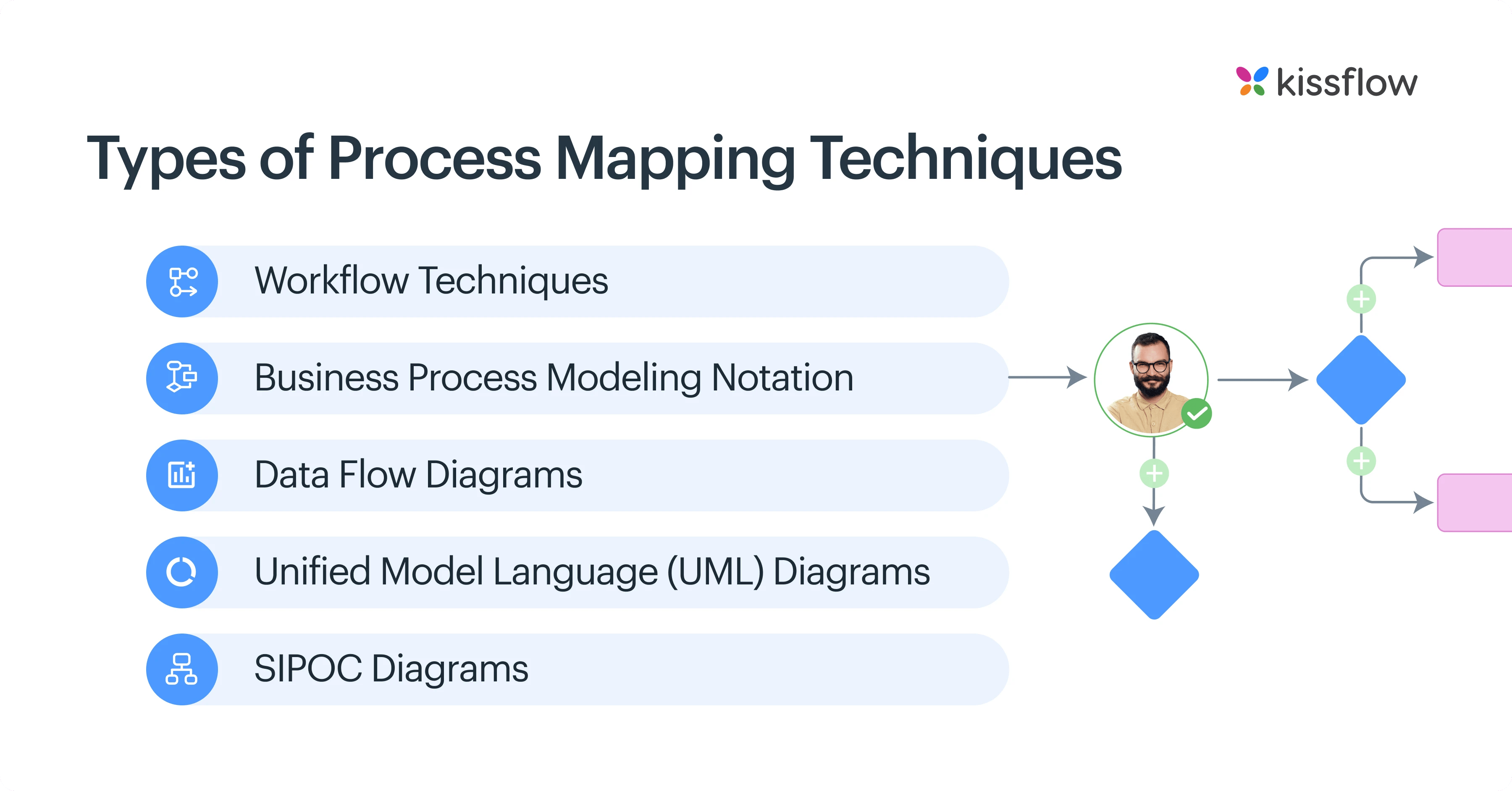
- >
- BPM Software >
- The Ultimate Guide to Process Mapping Techniques and Methods
The Ultimate Guide to Process Mapping Techniques and Methods
When your latest system integration project reveals that the same data is being manually entered into five different systems by four different departments, or when new hires spend their first month just figuring out who approves what, you're witnessing the chaos that occurs without proper process mapping techniques. As a technology leader overseeing digital transformation initiatives, you need precise visibility into how work actually flows through your organization—not how you think it should flow. IBM's 2024 Process Intelligence Study shows that organizations using structured mapping techniques identify 65 percent more automation opportunities and reduce process cycle times by an average of 40 percent.
What Is Business Process Mapping?
Business process mapping, as a subset of BPM, is a powerful way to visually depict processes. It allows you to see how a process functions from start to finish, one step after another.
BPM focuses on analyzing, optimizing, and automating processes to enhance efficiency and effectiveness. By mapping processes, companies can create a clear, structured approach to process improvement, ensuring alignment with organizational goals.
Business process mapping answers the following questions using charts, flowcharts, and symbols:
- What tasks constitute the processes?
- Who performs each task?
- At what stage does each task occur?

Why Do You Need Business Process Mapping?
Business process mapping is critical to boosting efficiency in an organization. Without clarity in processes, chaos, redundancies, delays, and a complete lack of accountability take over operations. A reliable BPM tool can help map, visualize, and streamline these processes—because nothing can drive a business to the ground faster than messy and vague workflows
Utilizing business process mapping can help your company in the following ways:
- Absolute clarity and control over processes
- Established operational norms
- Minimal errors
- Reduced bottlenecks
- Elimination of redundancies
- Improved compliance with industry standards
What are Process Mapping Techniques?
Process mapping techniques are systematic methodologies and tools used to visually document, analyze, and communicate business workflows, including flowcharts, swimlane diagrams, value stream mapping, and BPMN notation, designed to identify inefficiencies, standardize operations, and facilitate process improvement initiatives across organizational functions.

Unlock the Power of Comprehensive BPM Tools: Scale, Succeed, and Stay Ahead
Thanks for submitting the form.
What Are the Different Kinds of Process Mapping Techniques?

There are many types of process mapping techniques and methods. A long list might include: Gantt charts, UML diagrams, business process modeling notation, flowcharts, data flow diagrams, role activity diagrams, integrated definition for function modeling, Petri nets, object oriented methods, workflow technique, and simulation models, all with their own unique strength.
Some of the popular process mapping techniques include:
1. Workflow Techniques
Workflows comprise of sequences of tasks between people in an organization or between computer applications. They involve more than just modeling processes. They also help analyze and improve the processes. The various stages in a workflow include gathering information, business process modeling, workflow modeling, implementation, verification, and execution.
2. Business Process Modeling Notation (BPMN)
BPMN is a technique that is preferred by process experts. It is a standardized language that is ideal for situations when you need to drill down into processes to fix errors and exceptions. While it is very popular, if you’re not a business analyst, trying to utilize this technique could be counterproductive.
3. Data Flow Diagrams
Also known as Yourdon’s technique, data flow diagrams show you how information flows from one place to another. They represent how the process links through data stores and how it relates to the external environment.
4. Unified Model Language (UML) Diagrams
UML diagrams are best suited for mapping out software building. There are two categories within UML – behavioral and structural diagrams. UML is seen as a specialized mapping tool for specific industries, so it isn’t suited for creating process workflows.
5. SIPOC Diagrams
SIPOC diagrams are also called high-level process maps. They visually represent a process without going into too much detail. A SIPOC diagram breaks the process down into the following sections – suppliers, input, process, output, and customers.
Learn more: Process automation solutions
What Should an Ideal Process Mapping Software Look Like?
Assuming that improved business efficiency is your goal, the right process mapping software should be
- easily understood by all employees
- industry compliant
- easy to implement
- capable of facilitating analysis and improvement
- capable of simulating workflow before implementation
Business process mapping doesn’t need to be complex or require experts to be effective. After all, simplicity is the ultimate sophistication, as Leonardo da Vinci said.
Learn more: Process building software.
Check out why these BPM Tools are at the top of the competition!
Mapping Your Way To Growth
Kissflow is a powerful low-code platform that allows you to streamline business processes across the organization. With its intuitive visual approach and drag-and-drop editor, you can visually map processes and build them from scratch. Modern process automation software allows companies to replace manual, time-consuming tasks with automated workflows that scale. This shift not only improves accuracy but also accelerates the pace of work across departments.
Kissflow also offers a wide range of reporting and analytics features that give an accurate snapshot of the performance of different business processes, allowing you to identify and fix inefficiencies quickly.
Solve your workflow challenges with Kissflow and optimize your team's productivity.
Frequently Asked Questions
1. What are the different methods of process mapping?
Process mapping methods include flowcharts (sequential visualization of steps and decisions), swimlane diagrams (clarifying role responsibilities across departments), value stream maps (highlighting waste and delays), BPMN diagrams (using standardized notation for technical implementation), SIPOC diagrams (high-level overview of suppliers, inputs, process, outputs, and customers), and hierarchical process maps showing relationships between processes at different levels.
2. How do businesses use process mapping for efficiency?
Businesses use process mapping for efficiency by visualizing current workflows to identify redundancies and bottlenecks, creating standardization opportunities across departments or locations, documenting tribal knowledge to reduce dependency on specific employees, establishing baselines for measuring improvement efforts, facilitating employee training, and creating a shared understanding of how work flows through the organization.
3. What tools help with process mapping?
Tools that help with process mapping include visual diagramming software with process-specific templates, collaborative whiteboarding platforms for team input, process mining tools that automatically discover actual workflows from system logs, simulation software for testing improvement scenarios, mobile apps for capturing processes on-site, and integration capabilities with process execution platforms for implementation.
4. What industries benefit the most from process mapping?
Industries benefiting most from process mapping include manufacturing (optimizing production workflows), healthcare (improving patient journeys), financial services (streamlining complex compliance processes), government agencies (reducing bureaucracy), logistics (optimizing supply chains), and professional services (standardizing service delivery). Any organization with complex, cross-functional processes gains significant value.
5. What are common process mapping mistakes to avoid?
Common process mapping mistakes to avoid include mapping ideal processes rather than current reality, creating overly detailed maps that become unwieldy, failing to involve the people who actually do the work, ignoring exception handling for non-standard cases, using inconsistent notation that confuses participants, focusing solely on activities rather than outputs and value, and creating maps without clear purpose or follow-up actions.
6. Why do enterprises use different mapping techniques for different workflows?
Because process complexity varies. High-risk or cross-team workflows need structured BPMN or swimlane mapping, while simpler tasks may only require flowcharts. Choosing the right technique ensures clarity without over-modeling.
7. How do swimlane maps improve accountability?
They clearly show who owns each activity, where handoffs occur, and where delays originate.
8. When is BPMN the right mapping technique?
When workflows have multiple exceptions, decision paths, integrations, or compliance checkpoints.
9. How do mapping techniques help identify automation opportunities?
They expose repetitive tasks, delays, and manual loops that are ideal candidates for automation.
10. How should IT and business teams map together?
Business explains real operations; IT identifies integration and governance needs. Joint mapping prevents blind spots.
11. How can mapping techniques reduce rework later?
They validate logic early, ensuring automation mirrors actual processes.
Related Articles











%20(1)%20(1).png?width=1997&height=1800&name=The%20ultimate%20buyers%20guide%20to%20BPM%20(1)%20(1)%20(1).png)
